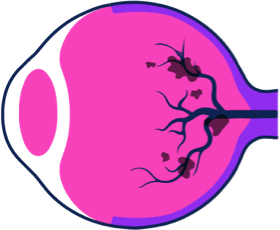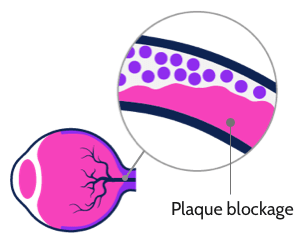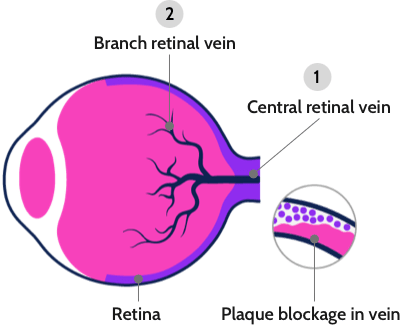
Retinal vein occlusion
Understanding retinal vein occlusion1,2
Retinal vein occlusion (RVO) takes place when one or a few of the blood vessels in the eye become blocked.
This can result in a sudden, painless change in vision.
If you’re concerned about yourself or a loved one, talk to your doctor and scroll to find out more.
Here are some of the key terms we use when talking about retinal vein occlusion:
- Retinal
The light-sensitive part of the eye that becomes damaged in RVO. - Vein
A blood vessel that carries blood away from the eye. - Occlusion
A blockage in a blood vessel that stops the flow of blood in that area.
- Blood supply
The movement of blood to an area, bringing oxygen and nutrients to keep it healthy. - Central vision
The part of your vision you use to focus clearly on something directly in front of you, like reading a book. - Peripheral vision
The part of your vision you use to gather rough information about your surroundings, like navigating through a crowd.
Symptoms of RVO2
The main symptom of RVO is a sudden, painless change in vision. However, there are others that may also occur.
While symptoms may vary from person to person, they’re usually a combination of those shown below:
RVO risk factors1,3,4
There are a number of risk factors to watch out for in RVO, including:
How does RVO affect the eye?
How does RVO develop?1,2,5
When blood supply is blocked to the retina it doesn't get enough oxygen.

As a result, the retina can’t send information to the brain to process vision.

This blockage can also cause swelling.
Without treatment, this can result in sudden and severe vision loss.
Two types of RVO1,2,5
There are two types of RVO, each depending on the type of blood vessel that’s affected.

Branch RVO
When smaller veins, or branches, in the retina are blocked we experience branch RVO (BRVO).
Central RVO
When the main vein in the retina is blocked, we experience central RVO (CRVO). This type of blockage is usually the most serious of the two.
References
1. Macular Society. Retinal vein occlusion. [Internet; cited March 2021]. Available from: https:// www.macularsociety.org/retinal-vein-occlusion
2. MacDonald, D. (2013). The ABCs of RVO: A review of retinal venous occlusion. Clinical and Experimental Optometry, n/a. https://doi.org/10.1111/cxo.12120
3. Petr Kolar, "Risk Factors for Central and Branch Retinal Vein Occlusion: A Meta-Analysis of Published Clinical Data", Journal of Ophthalmology, vol. 2014, Article ID 724780, 5 pages, 2014. https://doi.org/10.1155/2014/724780
4. Laouri M, Chen E, Looman M, Gallagher M. The burden of disease of retinal vein occlusion: review of the literature. Eye. 2011; 25:981-8.
5. Retinal Vein Occlusion. Guy’s and St Thomas. [Internet; cited April 2021]. Available from: https://www.guysandstthomas.nhs.uk/resources/patient-information/eye/retinal-vein-occlusion.pdf















